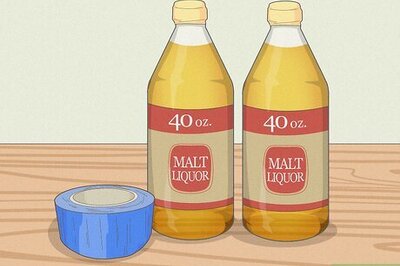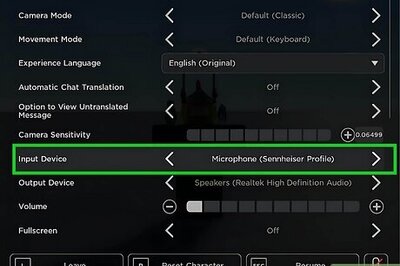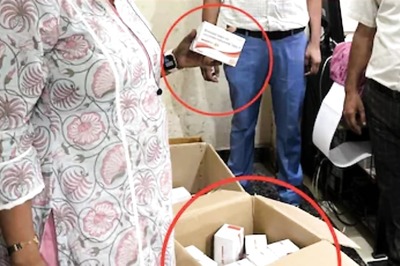
views
The “Pran Pratishtha” ceremony of Ram Lalla in Ayodhya on January 22, 2024, marked the end of 500 years of exile for the Lord’s devotees in India and across the country.
Crafted by the skilled sculptor Arun Yogiraj from Mysuru, the 51-inch-tall idol, portrays the image of a five-year-old Lord Ram. Prime Minister Narendra Modi actively participated in the ceremonial proceedings at the complex where over 8000 invitees were present.
Though it will take several months before the temple is finally complete, the consecration ceremony will open the grand temple to visitors on January 23, 2024. The construction of a grand Ram temple in Ayodhya kicked off on August 5, 2020 after the Supreme Court’s verdict in 2019.
Several big names including around 3,000 VVIPs, 4,000 saints and seers from different parts of the country, delegates from 50 countries and family members of the ‘Kar Sevaks’ who were part of the Ram temple movement attended the ceremony.
Here is a complete timeline of events of the Ram Temple in Ayodhya ever since the nineteenth century:
1853: The first recorded incident of religious violence took place in 1853, more than 230 years after the construction of Babri Masjid in Ayodhya. A Hindu sect, during the rule of Nawab Wajid Shah of Awadh, claimed that the Hindu temple had been destroyed during the rule of Mughal ruler Babur.
1885: In January 1885, Mahant Raghubir Das filed a plea in Faizabad district court, seeking permission to build a canopy on the Ramchabutra outside the mosque. However, the plea was rejected.
1949: Gopal Singh Visharad files a petition before a Faizabad court to worship the deity of Ram Janambhoomi after idols of Ram Lalla were found inside Babri Masjid. Muslims allege that Hindus placed idols of Lord Ram inside the mosque leading to civil suits by both parties. The government proclaims the premises a disputed area and locks the gates.
1961: Mohammad Hashim filed a suit pleading for restoration of the property to Muslims. The Sunni Central Wakf Board filed suit in Faizabad civil court declaring Babri Mosque as the property of board.
1984: The Vishwa Hindu Parishad spearheads a movement to ‘liberate’ the birthplace of Lord Ram and build a temple. Then Bharatiya Janata Party (BJP) leader LK Advani takes over leadership of the campaign.
1986: Ayodhya District judge orders the gates of the disputed mosque to be opened to allow Hindus to worship there on a plea by Hari Shankar Dubey. The Babri Mosque Action Committee is set up in protest.
1989: The Vishwa Hindu Parishad (VHP) lays the foundations of a Ram temple on land adjacent to the disputed mosque. Four suits that were pending at the Faizabad court were transferred to a special bench of the High Court.
1990: The BJP under the leadership of then President LK Advani ordered a national Rath Yatra from Somnath in Gujarat to Ayodhya. The procession passed through hundred of cities and villages and led to several communal riots. VHP volunteers partially damage the mosque. Prime Minister Chandra Shekhar tries to resolve the dispute through negotiations.
1991: BJP comes to power in Uttar Pradesh.

1992: on December 6, 1992, the mosque is torn down by supporters of the VHP, the Shiv Sena and the BJP, prompting nationwide rioting between Hindus and Muslims. The demolition led to widespread communal riots across the country, in which, 2,000 people died.
1998: The BJP forms a coalition government under Prime Minister Atal Behari Vajpayee.
2001: Tensions rise on the anniversary of the demolition of the mosque. VHP pledges again to build Hindu temple at the site. Vajpayee sets up an Ayodhya cell in his office and appoints a senior official, Shatrughna Singh, to hold talks with Hindu and Muslim leaders.
2002: BJP rules out committing itself to the construction of a temple in its election manifesto for Uttar Pradesh assembly elections. VHP confirms deadline of March 15 to begin construction. Hundreds of volunteers converge on site. At least 58 people are killed in an attack on a train in Godhra which is carrying Hindu activists returning from Ayodhya.
March 2002: Hundreds of people die in riots in Gujarat following the train attack.
April 2002: Three High Court judges begin hearings on determining who owns the religious site.
January 2003: Archaeologists begin a court-ordered survey to find out whether a temple to Lord Ram existed on the site.
August 2003: The survey says there is evidence of a temple beneath the mosque, but Muslims dispute the findings.
September 2003: A court rules that seven Hindu leaders should stand trial for inciting the destruction of the Babri Mosque. No charges are brought against Advani.
November 2004: A court in Uttar Pradesh rules that LK Advani’s role in the demolition of the Babri Masjib be reviewed.
July 2005: Suspected militants attack the makeshift Ram temple at the site, using a jeep laden with explosives. The CRPF shoots dead all five militants in a gunfight while one civilian dies in the grenade attack that the terrorists launched in order to breach the cordoned wall.
June 2009: The Liberhan commission investigating the mosque’s demolition submits its report.
July 2010: The High Court finishes hearing the title suit, verdict is awaited.
September 2010: Allahabad High Court on September 30, 2010 ordered that the 2.77 acre disputed site be divided into three parts among the Hindus, the Muslims and the Nirmohi Akhara. Petitions filed by Mahant Suresh Das, the Sunni Central Board of Wakfs, Nirmohi Akhara, the Akhil Bharat Hindu Mahasabha, Jamait Ulama-I-Hind and others challenged the verdict. A petition was also filed on behalf of Ram Lalla challenging the HC verdict.
2011: All three parties in the case: Nirmohi Akhara, Ram Lalla Virajman and Sunni Waqf Board appealed against the Allahabad High Court verdict. The Supreme Court stayed the HC order of splitting the disputed site into 3 parts.
2019: In November 2019, a five-judge bench of the Supreme Court ordered the disputed land to be handed over to a trust to build the Ram Janmabhoomi temple. The court also ordered the government to allocate five acres of land in another place to the Sunni Waqf Board to build a mosque.
2020 Foundation Stone Laying Ceremony: On August 5, Prime Minister Narendra Modi laid the foundation stone for the construction of Ram Temple. He performed Bhoomi Poojan and laid the foundation stone of the grand Ram temple. Modi became the first Prime Minister to have Darshan at Ram Janmbhumi and Hanumangarhi temple of Ayodhya.
22 January 2024: The “Pran Pratishtha” ceremony of Ram Lalla took place at the temple complex in Ayodhya. Devotees will be able to visit the temple from January 23.

















Comments
0 comment